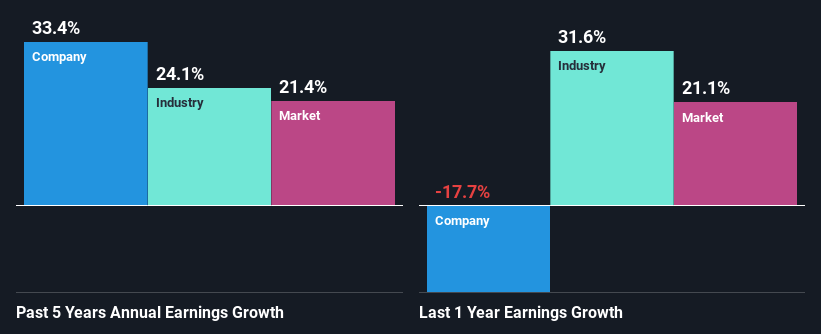Stock Analysis
- India
- /
- Real Estate
- /
- NSEI:PHOENIXLTD
Are Strong Financial Prospects The Force That Is Driving The Momentum In The Phoenix Mills Limited's NSE:PHOENIXLTD) Stock?

Most readers would already be aware that Phoenix Mills' (NSE:PHOENIXLTD) stock increased significantly by 35% over the past three months. Since the market usually pay for a company’s long-term fundamentals, we decided to study the company’s key performance indicators to see if they could be influencing the market. In this article, we decided to focus on Phoenix Mills' ROE.
Return on Equity or ROE is a test of how effectively a company is growing its value and managing investors’ money. Simply put, it is used to assess the profitability of a company in relation to its equity capital.
View our latest analysis for Phoenix Mills
How Is ROE Calculated?
Return on equity can be calculated by using the formula:
Return on Equity = Net Profit (from continuing operations) ÷ Shareholders' Equity
So, based on the above formula, the ROE for Phoenix Mills is:
11% = ₹13b ÷ ₹124b (Based on the trailing twelve months to March 2024).
The 'return' is the profit over the last twelve months. That means that for every ₹1 worth of shareholders' equity, the company generated ₹0.11 in profit.
What Is The Relationship Between ROE And Earnings Growth?
So far, we've learned that ROE is a measure of a company's profitability. Depending on how much of these profits the company reinvests or "retains", and how effectively it does so, we are then able to assess a company’s earnings growth potential. Generally speaking, other things being equal, firms with a high return on equity and profit retention, have a higher growth rate than firms that don’t share these attributes.
Phoenix Mills' Earnings Growth And 11% ROE
When you first look at it, Phoenix Mills' ROE doesn't look that attractive. However, the fact that the its ROE is quite higher to the industry average of 6.6% doesn't go unnoticed by us. Especially when you consider Phoenix Mills' exceptional 33% net income growth over the past five years. Bear in mind, the company does have a moderately low ROE. It is just that the industry ROE is lower. So, there might well be other reasons for the earnings to grow. For example, it is possible that the broader industry is going through a high growth phase, or that the company has a low payout ratio.
As a next step, we compared Phoenix Mills' net income growth with the industry, and pleasingly, we found that the growth seen by the company is higher than the average industry growth of 24%.

Earnings growth is an important metric to consider when valuing a stock. It’s important for an investor to know whether the market has priced in the company's expected earnings growth (or decline). By doing so, they will have an idea if the stock is headed into clear blue waters or if swampy waters await. If you're wondering about Phoenix Mills''s valuation, check out this gauge of its price-to-earnings ratio, as compared to its industry.
Is Phoenix Mills Making Efficient Use Of Its Profits?
Phoenix Mills' three-year median payout ratio to shareholders is 18%, which is quite low. This implies that the company is retaining 82% of its profits. So it seems like the management is reinvesting profits heavily to grow its business and this reflects in its earnings growth number.
Additionally, Phoenix Mills has paid dividends over a period of at least ten years which means that the company is pretty serious about sharing its profits with shareholders. Upon studying the latest analysts' consensus data, we found that the company's future payout ratio is expected to drop to 7.0% over the next three years. As a result, the expected drop in Phoenix Mills' payout ratio explains the anticipated rise in the company's future ROE to 16%, over the same period.
Conclusion
Overall, we are quite pleased with Phoenix Mills' performance. In particular, it's great to see that the company has seen significant growth in its earnings backed by a respectable ROE and a high reinvestment rate. With that said, the latest industry analyst forecasts reveal that the company's earnings growth is expected to slow down. To know more about the company's future earnings growth forecasts take a look at this free report on analyst forecasts for the company to find out more.
Valuation is complex, but we're helping make it simple.
Find out whether Phoenix Mills is potentially over or undervalued by checking out our comprehensive analysis, which includes fair value estimates, risks and warnings, dividends, insider transactions and financial health.
View the Free AnalysisHave feedback on this article? Concerned about the content? Get in touch with us directly. Alternatively, email editorial-team (at) simplywallst.com.
This article by Simply Wall St is general in nature. We provide commentary based on historical data and analyst forecasts only using an unbiased methodology and our articles are not intended to be financial advice. It does not constitute a recommendation to buy or sell any stock, and does not take account of your objectives, or your financial situation. We aim to bring you long-term focused analysis driven by fundamental data. Note that our analysis may not factor in the latest price-sensitive company announcements or qualitative material. Simply Wall St has no position in any stocks mentioned.
Valuation is complex, but we're helping make it simple.
Find out whether Phoenix Mills is potentially over or undervalued by checking out our comprehensive analysis, which includes fair value estimates, risks and warnings, dividends, insider transactions and financial health.
View the Free AnalysisHave feedback on this article? Concerned about the content? Get in touch with us directly. Alternatively, email editorial-team@simplywallst.com
About NSEI:PHOENIXLTD
Phoenix Mills
Engages in the operation and management of malls, construction of commercial and residential properties, and hotel business in India.
Adequate balance sheet with moderate growth potential.

